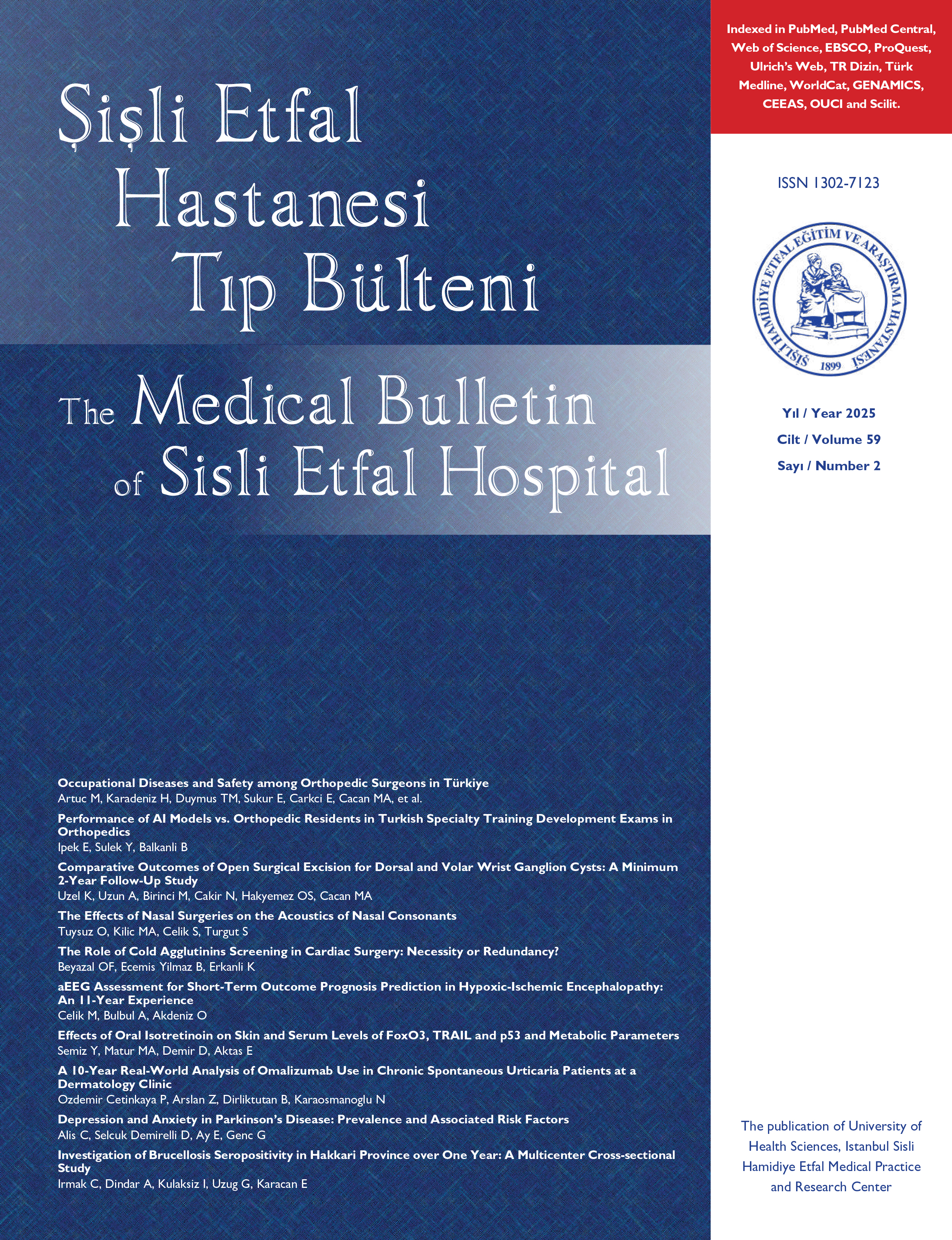
Volume: 42 Issue: 3 - 2008
| ORIGINAL RESEARCH | |
| 1. | Comparison of the effectiveness of ringer lactate and HES on prevention of spinal anaesthesia related hypotension G. Ulufer Sivrikaya, Ayşe Hancı, Birsen Ekşioğlu, Hale Dobrucalı Pages 1 - 6 Objective: One of the techniques to prevent spinal anaesthesia related hypotension is, intravascular volume expansion using intravenous fluid (preload) before spinal anaesthesia. In our study we aimed to compare the effectiveness of Ringer lactate and hydroxy ethyl starch (HES) and their combination in prevention of spinal anaesthesia related hypotension. Study design: 60 patients undergoing inguinal hernia repair operation were allocated randomly to three groups to receive either; in Group I: 10 ml/kg Ringer lactate or in Group II: 10 ml/kg HES %6 or in Group III: 5 ml/kg Ringer lactate and 5 ml/kg HES %6 combination infused in 20 minutes before spinal anaesthesia. Systolic blood pressure (SBP) and heart rate (HR) values were followed. Hypotension was defined as a decrease of 30% or more below baseline values or <90 mmHg and was planned to treat with repeated ephedrine bolus doses. Incidence of hypotension, ephedrine consumption and side effects were recorded. Results: Minimum SBP and HR values were significantly lower and incidence of hypotension was significantly higher in Group I compared to Group II and Group III (p<0.05). Ephedrine consumption was significantly higher in Group I than Group III (p<0.05). Conclusion: We conclude that; fluid preloading with HES alone or Ringer lactate+HES combination are more effective than crystaloid alone in prevention of spinal anaesthesia related hypotension. |
| 2. | The effects of different doses of intranasal midazolam used for premedication in children Mine Özgümüş, G. Ulufer Sivrikaya, Metin Bektaş, Ayşe Hancı Pages 7 - 12 Objective: Midazolam is a benzodiazepine and frequently preferred as a premedicant agent. Nasal application of the drugs has important advantages as; rapid absorbtion and rapid onset caused by rapid absorbtion of the drug to the systemic circulation. In our study; we aimed to compare the effects of different doses of intranasal midazolam on sedation and parental seperation when used for premedication in pre-scholl children. Study design: After the approval of Ethics Committee of Sisli Etfal Training and Research Hospital and informed consent of the parents, 60 patients aged 2-6 years in ASA I-II physical status randomized into three groups. Premedication was produced with intranasal midazolam with 0.3 mg/kg in Group I, 0.4 mg/kg in Group II and 0.5 mg/kg in Group III. Sedation and parental seperation scores and adverse effects were recorded as study parameters. Results: Sedation scores were similar between the three groups (p>0.05). Sedation scores were significantly lower in 25. and 30. minutes compared to 10. min in all three groups (p<0.05). Parental seperation scores were similar between the groups (p>0.05). Conclusion: We conclude that; 0.3 mg/kg intranasal midazolam is an effective and safe dosage when conscious sedation was aimed for premedication in pre-school children and higher doses are not necessary. |
| CASE REPORT | |
| 3. | Glucose galactose malabsorption during neonatal period: Two case reports Ali Bülbül, Füsun Okan, Lida Bülbül, Asiye Nuhoğlu Pages 13 - 16 Glucose-galactose malabsorption is an autosomal recessive disorder caused by defects in the Na+/glucose cotransporter. Because of defective cotransport of glucose and galactose in the intestinal mucosa infants with glucose-galactose malabsorption suffer from chronic, profuse, watery diarrhea that often leads to hypernatremic dehydration. If not diagnosed and treated, the condition can be fatal. On the other hand, if appropriate dietary carbohydrate restriction is applied, the diarrhea stops and the child develops normally. We report two cases diagnosed as glucose-galactose malabsorption during the neonatal period. The cases were presented to emphasize that glucose- galactose malabsorption which is a rare disorder of carbohydrate metabolism, should be considered in differential diagnosis of chronic diarrhea in the neonatal period. |
| 4. | Unilateral spinal anasthesia in an ASA IV-E patient: Case report U. Hale Dobrucalı, Leyla Türkoğlu, Ulufer Sivrikaya, Canan T. Işıl, Ayşe Hancı Pages 17 - 19 Spinal anaesthesia is commonly used in lower extremity operations and is prefered to general anaethesia for reasons like reducing morbidity in high risk patients and inhibiting stress after surgery. Still it can cause cardiovascular changes like hypotantion and bradycardia. So unilateral anaesthesia is prefered in high risk patients for less hemodynamic instability. We aimed to share our unilateral spinal anaesthesia experience in an ASA IV E patient with ejection fraction 28%. |
| 5. | Twin to twin transfusion syndrome - A case review Inci Davas, Ahmet Varolan, Kadir Bakay, Atıf Akyol, Ali Yazgan Pages 20 - 22 Çoğul gebelikler tüm gebeliklerin yaklaşık olarak 250de 1 ini oluşturur. İntrauterin ve perinatal morbidite ve mortalite oranları daha yüksek olmakla beraber, preeklampsi, preterm doğum, intrauterin gelişme geriliği ve ikizden ikize transfüzyon sendromu gibi gebeliği komplike eden durumlarla daha sık karşılaşılır. Tüm ikiz gebeliklerin yaklaşık olarak %20si 35. haftada sonlanmakta ve ikiz gebeliklerin yaklaşık %60ının doğum ağırlığı 2500 gın altında olmaktadır. Bu olguda monokoryonik diamniotik bir ikiz gebelikte ikizden ikize transfüzyon sendromu tanısı aldıktan sonra 35. haftada sonlandırılmasını literatür eşliğinde tartışmayı amaçladık. |
| 6. | Ecstasy use complicating with ICA dissection; A case report Ender Uysal, Önder Kırdar, Alper Özel, Şükrü Mehmet Ertürk, Hakan Yıldırım, Ismail Caymaz, Muzaffer Başak Pages 23 - 25 Ecstasy, is a three ring-substituted, methoxylated analogue of metamphetamine is widely used reactional drug, which may cause cerebrovascular accidents, including cerebral infarction, cerebral hemorrhage and cerebral venous thrombosis. An 18-year old man had vertigo, left lower and upper extremity weakness and incontinence symptoms. The patient had taken Ecstasy several times in 4-5 months. Diffusion weighted magnetic resonance imaging showed an acute infarction at the posterior limb of the right internal capsule in the anterior chorodial artery area. Conventional cerebral angiogram demonstrated high grade stenosis of supraclinoid segment of the right internal carotid artery (ICA) and irregular vessel wall. We believe the present case in which there were no other recognized risk factors for cerebrovascular disease, is the first to suggest a link between ICA dissection with ecstasy abuse. |
| 7. | Congenital afibrinogenemia in neonatal period: Two cases and review of literature Ali Bülbül, Füsun Okan, Aykut Çağlar, Yıldız Yıldırmak, Lida Bülbül, Asiye Nuhoğlu Pages 26 - 29 Congenital afibrinogenemia is a rare autosomal recessive coagulation disorder characterized by the complete absence of detectable fibrinogen. The causal mutations have been identified in less than 20% of the cases. The most frequently reported and often the first sign of the disorder is umbilical cord bleeding. Gum bleeding, epistaxis, hemarthrosis usually manifest in early childhood and intracerebral bleeding and splenic rupture can occur throughout life. We report two cases with umbilical cord bleeding and diagnosed as congenital afibrinogenemia in the neonatal period. |



















